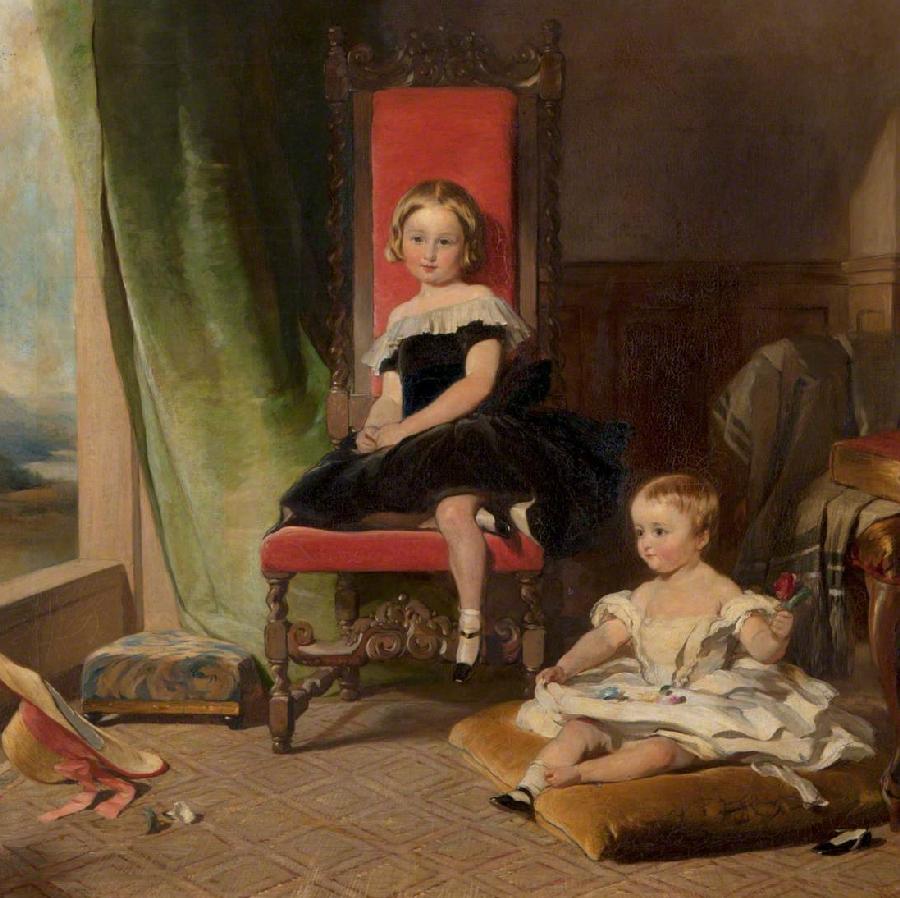
Artists Illustrating Boys' Fashions: James Currie (Scotland, active 1846- )

Figure 1.--This Janes Currie portrait shows two of the younger children of William Broadie -- Caithness and William. It is a very sweet depictiom of the children in their Castle Brodie nursery. Given their ages, it would have been painted about 1846. Willian is still an infant, but dressed in an elaborate white perhaps satin dress. Caitness wears a black velvet, ruffled trim dress. Her straw hat with a pink streamer is tossed on the floor. Notice the low necklines which were common for younger children in the first half of the 19th century. The Sottish Highlands are on display out the window.
|
|
James Currie is decribed as a 'British' artist. Tht suggests he was active in both England and Scotland. We have been unable to find much information about him. We do not even know where he was born. We do know he was active from 1846. We have not found many Currie paintings, but the ones we have found are all portraits. He seems a proessionally competent if not great artist. He was connected with the Brodie family in Scotland and painted several portraits of the family in the mid-19th century. The Brodies were a notable Scottish family since the 12th century. The family estate was Brodie Castle. Currie painted the family of Willim Brodie and his wife Elizabeth Baillie, the 22nd Laird. There were six children: George Gordon (1839- ), Hugh Fife Ashley (1840- ), Caithness Druim (1842- ), and William Douglas (1845- ), and two other children. There do not appear to have been any surviving sisters. Currie has left us several important images as to how children from a rich Scottish family dressed in the mid-19th century.
James Currie
James Currie is decribed as a 'British' artist. That suggests he was active in both England and Scotland. His connection with the Brodie family high in the Higlands suggests he was Scottish. We have been unable to find much information about him. We do not even know where he was born. He is said to be active from 1846, but the Brodie portraits suggest to us that he began painting them a few years earlier, but all during the 1840s. We have not found many Currie paintings, but the ones we have found are all portraits. He seems a proessionally competent if not a great artist.
Currie was connected with the Brodie family in Scotland and painted several portraits of the family in the mid-19th century. The Clan Brodie were a notable Scottish family since the 12th century.
Their origins are uncertain. The first known Brodie chiefs were the Thanes of Brodie and Dyke in the norther Higlands--Morayshire. The Brodies were present in several clan conflicts, and during the civil war were ardent covenanters. They resisted involvement in the Jacobite uprisings, and the chief's family later prospered under the British Empire in colonial India. The family estate was Brodie Castle. It was built in the 16th century, but largely destroyd in clan conflict during the 17th centuy. The presnt structure ts a restoration of the originl, although the tower is believed to date back to 1430 and the newest parts were added 1820–30. It is located near Forres, in Moray, about as far north as one can go in the Scottish Highlands. Alexander Brodie was the 20th Lairds and a 18th century portrait exists of him as a boy by Charles Phillips. William Brodie (1799-1873) was the 22nd Laird of Brodie. An early painting by John Opie in the early-19th century shows William Brodie as a boy with his brothers, sisters, and a huge dog. William wears a red skeleton suit and all the other children wear plain long Empire-style dresses without a tartan in sight. Some of the yonger childrn must be boys. A few decades later, Currie painted a very destinguished looking William as an adult with his wife Elizabeth Baillie and their children during the 1840s. There were six children: George Gordon (1839- ), Hugh Fife Ashley (1840- ), Caithness Druim (1842- ), and William Douglas (1845- ), and two other children. There do not appear to have been any surviving sisters. Currie has left us several important images as to how children from a rich Scottish Highland family dressed in the mid-19th century. The Scottish influence is much stronger thn was the case when William was growing up which of course we an credit at least in part to Queen Victoria. The Curie paintings mages show the boys wearing dresses and kilts. Apparently they wore tartan dresses before being dresed in kilts.
HBC

Navigate the Boys' Historical Clothing Web Site:
[Return to the Main individual A-F artist alphabetical page]
[Return to the Main Scottish artist page]
[About Us]
[Introduction]
[Activities]
[Biographies]
[Chronology]
[Clothing styles]
[Countries]
[Bibliographies]
[Contributions]
[FAQs]
[Glossaries]
[Images]
[Links]
[Registration]
[Tools]
[Boys' Clothing Home]
Created: 3:52 AM 12/12/2017
Last updated: 3:52 AM 12/12/2017



